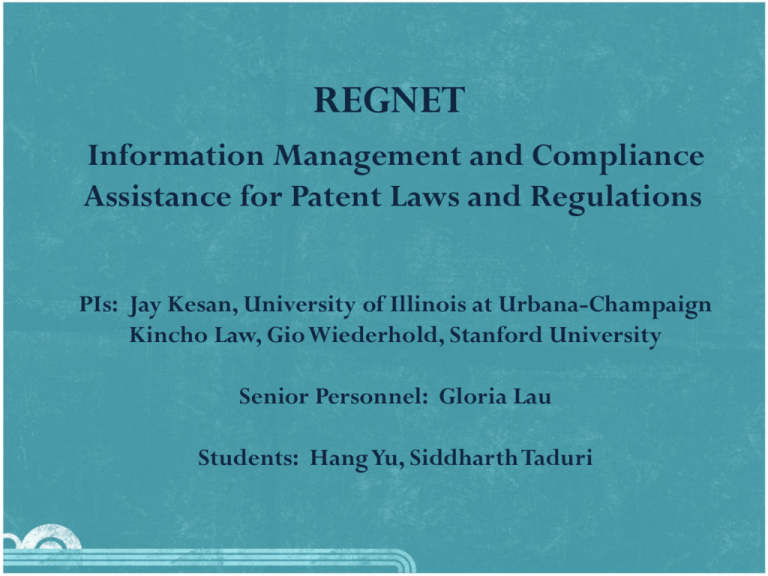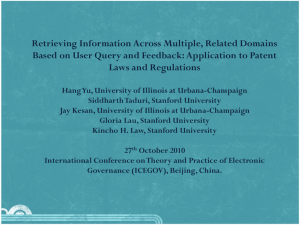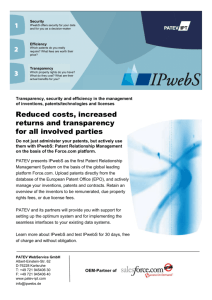NSF III 2010 - Stanford University
advertisement

REGNET Information Management and Compliance Assistance for Patent Laws and Regulations PIs: Jay Kesan, University of Illinois at Urbana-Champaign Kincho Law, Gio Wiederhold, Stanford University Senior Personnel: Gloria Lau Students: Hang Yu, Siddharth Taduri PROBLEM STATEMENT 2 Motivation Technology Firms’ Concerns • Can I get patent protection for my innovation? • Do I build or do I buy related technologies? • What are my competitors doing? • How strong are their patents? • Am I perhaps infringing on someone else’s patents? • Is so, are those patents valid? • Have they been enforced in court? • Has their validity been challenged in court? 04/22/10 PROBLEM STATEMENT PATENTS PUBLICATIONS PTO FILE WRAPPERS COURT CASES LAWS & REGULATIONS 3 Motivation 04/22/10 BACKGROUND 4 Motivation 04/22/10 PATENTS 500,000 450,000 400,000 350,000 300,000 250,000 200,000 150,000 100,000 Patent Applicati ons 2004 2005 2006 2007 2008 Granted Patents 5 Challenges 04/22/10 IP LITIGATION 6 Challenges 04/22/10 USPTO PROCEEDINGS: FILE WRAPPERS 7 Challenges 04/22/10 SCIENTIFIC PUBLICATIONS 8 Challenges 04/22/10 PROPOSED FRAMEWORK Step 1: Expand Keywords User Query Framework Step 2: Independently search domains Step 3: Combine Results + Rank Step 4: Consider User Feedback 9 Proposed Framework 04/22/10 STEP 1: EXPAND KEY WORDS Goal: Expand the user query using ontologies/taxonomies (BioPortal, GeneCards, MedTerms) Simple Example: Doc A The car has a 3.5l V6 engine Doc B The vehicle has a 3.5l V6 engine Keyword search for “car” will return only Doc A. An ontology that describes the term “vehicle” as a synonym, or a parent of “car” will internally expand the query to return both Doc A and Doc B Challenges: 10 Proposed Framework 04/22/10 STEP 2: INDEPENDENTLY SEARCH DATABASES Goal: Find relevant documents in a database of homogenous documents (e.g., Patents, or publications) Challenges: 11 Proposed Framework 04/22/10 STEP 3: COMBINE RESULTS FROM THE FOUR DIFFERENT DOMAINS Goal: (1) Cross-reference results from other domains (2) Rank results Challenges: 12 Proposed Framework 04/22/10 STEP 4: CONSIDER USER FEEDBACK Goal: Consider user feedback from domain experts Challenges: 13 Proposed Framework 04/22/10 EXPERIMENTATION/METHODOLOGY 14 Use Case: EPO 04/22/10 USE CASE: EPO/ERYTHROPOIETIN Why does this make a good use case? 15 Use Case: EPO 04/22/10 PATENTS Search results for “erythropoietin” amongst the 135 closely related patents: Patent Number 5955422 6204247 6245740 6270989 6280977 6340742 6420339 6420340 6524818 Rank 0.109 0.000 0.018 0.000 0.027 0.113 0.000 0.000 0.009 U.S. Patent No. 6,204,247 is relevant but does not contain the term erythropoietin Q: How can this be made better? 16 Use Case: EPO 04/22/10 ONTOLOGY a b (a) Gene Ontology (b) NCI Thesaurus 17 Use Case: EPO Expanded Term Base “Erythropoietin”, “Erythropoietin Receptor Binding”, “Colony Stimulating Factor”, “Cytokine” … 04/22/10 RESULTS AFTER USING EXPANDED TERM BASE Patent Number 5955422 6204247 6245740 6270989 6280977 6340742 6420339 6420340 6524818 18 Use Case: EPO Rank 0.050 0.028 0.038 0.005 0.008 0.049 0.026 0.028 0.015 04/22/10 ADDITIONAL FEATURES Metadata: assignee, inventor, location, date, classification… Q: How is this data useful? 19 Use Case: EPO 04/22/10 OTHER ISSUES AND CHALLENGES 20 Other issues and challenges 04/22/10 CURRENT STATUS & FUTURE WORK Current Status Future Work 21 Current Status and Future Work 04/22/10 USEFUL LINKS 22 Patents USPTO – http://www.uspto.gov/ Delphion – http://www.delphion.com/ Google Patents – http://www.google.com/patents/ File Wrappers PAIR – http://portal.uspto.gov/external/portal/pair/ Court Cases PACER – http://pacer.psc.uscourts.gov/ Publications Pubmed – http://www.ncbi.nlm.nih.gov/pubmed/ Medline – http://www.nlm.nih.gov/medlineplus/ Google Scholar – http://scholar.google.com/ Ontology/Taxonomy BioPortal – http://bioportal.bioontology.com/ Genecards – http://www.genecards.org/ MedTerms – http://www.medterms.com/ Miscellaneous Thomson Innovation – http://www.thomsoninnovation.com/ Dialog – http://www.dialog.com/ 04/22/10 ACKNOWLEDGEMENT This research is partially supported by NSF Grant Number 0811975 awarded to the University of Illinois and NSF Grant Number 0811460 to Stanford University. Any opinions and findings are those of the authors, and do not necessarily reflect the views of the National Science Foundation. 23 04/22/10 DISCUSSION 24 04/22/10





